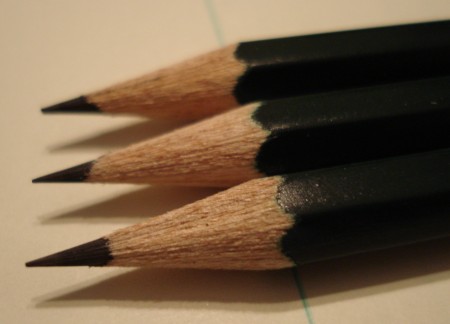
The Castell 9000 is a famous and iconic pencil. A flagship product of Faber-Castell, the world’s largest pencil company, the 9000 has over a century of history as an important working tool of writers, artists and engineers.
The dark rich green (“forest green”) has varied in shade over the years, but the current version is excellent. It makes for a very handsome pencil. It seems similar to the palette used by both Mazda and Land Rover in the automotive field.
Most 9000 pencils are sold sharpened, without eraser. (There is a variant with eraser.) There is a wide range of hardnesses offered, but today we’ll restrict ourselves to the HB version.
Following the methods mentioned in the Staedtler Mars Lumograph post, I weighed several pencils. The range was 3.6 to 4.1 grams, with the mean 3.9 grams. So it may be a sliver heavier than the Lumograph, our reference pencil. The length is the standard 175mm. The distance between opposite sides in 7.3mm, making it slightly narrower than the Lumograph. Being thinner yet heavier than the Lumograph is presumably due to the wood.
There is only one noticeable physical difference – the hexagonal edges are slightly less rounded on the Castell 9000 than on the Lumograph. I like this, and think it may slightly improve the grip.
Let’s introduce some terminology to describe the six sides of a hexagonal pencil. We’ve already used the ‘obverse’ and ‘reverse’ terms (borrowed from the numismatic field) in previous reviews.
Side 1: The pencil’s obverse – the pencil’s main markings – usually the manufacturer and model names.
Side 2: The next side, viewed clockwise, from the perspective of the pencil’s cap.
Side 3: Again, the next side of the pencil.
Side 4: The pencil’s reverse, opposite the obverse – often the location of a bar code or secondary information. (e.g. The full model number rather than just the marketing name.)
Side 5: Again, the next side of the pencil.
Side 6: Again, the next side of the pencil.
So with this terminology, the pencil is marked (in gold colouring):
Side 1 (Obverse): Castell 9000 Faber-Castell HB
Side 2: blank
Side 3: 4 005401 190004 [bar code] HB
Side 4 (Reverse): blank
Side 5: Water-based varnish Wasserlack SV Made in Germany www.Faber-Castell.com HB
Side 6: blank

I like pencils with clean looks – and this is just too much writing – three different sides of the pencil, each half covered with text.
It’s a great writer. Side-by-side with the Lumograph, the Castell 9000 is just a touch harder and lighter. The point seems unusually good at staying sharp. In B, right up to 4B, the pencil becomes buttery smooth.
I’d like to be able to better describe a pencil’s marking capabilities, but this is a challenging problem for which I haven’t found a satisfactory solution – the pressure used, the angle of application, the shape of the lead prior to use, and the paper are all important contributing variables. Paper can be standardized, but the other factors probably require special equipment to reproduce. I presume pencil companies have this type of equipment (a pencil gripping robot?) for their testing.
Perhaps the best endorsement is the century of commercial success experienced by the Castell 9000.
If you’ve somehow avoided this pencil – pick up a few to try. I doubt you will be disappointed.
Some additional reading:
November 2005 post at pencil talk
Faber-Castell pages on the Castell 9000
Leadholder.com page on these pencils, including links to historic catalogs. An excellent source if you’re seeking to date a particular pencil or learn more.
